Throughout the 2013 school year, students, teachers, and community members worked tirelessly to implement service-learning projects across the country. PLT supported 29 inspiring projects in 17 states and the District of Columbia through our GreenWorks! grant-giving program. Here are just a few highlights from the many impressive environmental improvement projects.
Exploring Mars and Recycling on Earth
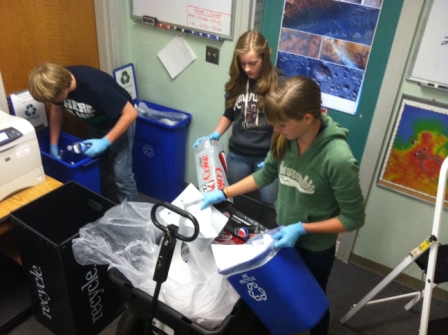 7th grade students at Evergreen Middle School in Cottonwood, California, reached for the stars with two service-learning projects. Their student-led NASA Research Team members and teachers are passionate about studying Mars. In 2010, the school received national attention for discovering a new cave by closely examining images of the planet’s surface.
7th grade students at Evergreen Middle School in Cottonwood, California, reached for the stars with two service-learning projects. Their student-led NASA Research Team members and teachers are passionate about studying Mars. In 2010, the school received national attention for discovering a new cave by closely examining images of the planet’s surface.
To support their work on the Mars Student Imaging Project and their yearly trip to the NASA AMES Facility in Mountain View, California, the team came up with a plan to raise funding. They initiated a school-wide recycling program for which they received a PLT GreenWorks! grant to help them get started. Students distributed recycling bins and collected paper, cardboard, plastic bottles, and aluminum cans in their classrooms, the district offices, and at school-community events. Each week they took all of the materials to local recycling facilities and the money earned from recycling efforts supported the Research Team’s expenses.
“The most rewarding (and most successful) part of the project has been the buy-in of the students on the team. The students [were] relentless in their pursuit to collect the materials. They often came in on their own time before school and at lunch to collect the materials,” said Dennis Mitchell, 7th grade Math, Science, Technology, and Service Learning Coordinator at Evergreen Middle School, and a 1999 National PLT Outstanding Educator.
Composting in the Classroom
 YMCA Camp Minikani in Hubertus, Wisconsin, started an in-school environmental education outreach program to teach students at numerous Wisconsin schools about decomposing materials and composting.
YMCA Camp Minikani in Hubertus, Wisconsin, started an in-school environmental education outreach program to teach students at numerous Wisconsin schools about decomposing materials and composting.
During weekly visits for six weeks, 4th through 8th grade students learned how items are disposed, where their garbage goes, and what happens to the trash. To demonstrate concepts like decomposition, Camp Minikani staff led hands-on lessons and group activities including Activity 23, The Fallen Log from PLT’s PreK-8 Environmental Education Activity Guide.
As students learned more about decomposition, they were asked to consider objects like leather boots, banana peels, plastic jugs, and newspapers, then estimate how long they think it takes each item to decompose. Students were surprised to find that some items take hundreds of years to decompose while other items never do.
In a later lesson, Camp Minikani staff introduced the concept of composting and shared examples of materials that can and cannot be used. Using plastic jugs, they helped the students set up an experiment designed to illustrate factors that affect composting. Holes were poked into one bottle to mimic windy conditions, another bottle had no water to represent composting in a dry environment, the next bottle had too much water to simulate a wet environment, and the last bottle was the control. Over the following weeks, groups of students added compostable wastes to their bottles, observed any changes, and identified the differences between composting in various conditions.
After discovering that bottles with water led to faster decomposition rates, while drier conditions led to minimal change, the students were ready to initiate a composting program at their schools. Students educated others on composting and came up with the method and schedule for collecting food wastes at lunch. Camp Minikani staff set up large composters outside that the students are continuing to use regularly, and many students are making plans to expand the program to compost school-wide.
Creating a Wildlife Garden
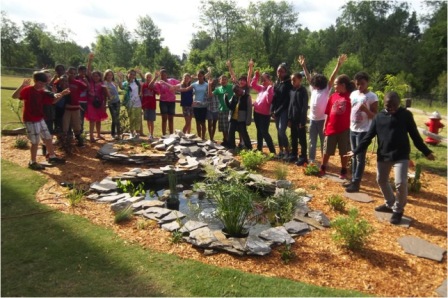 Catawba Trail Elementary in Elgin, South Carolina, expanded their existing butterfly and bird garden to make a new home for fish, amphibians, and other aquatic life.
Catawba Trail Elementary in Elgin, South Carolina, expanded their existing butterfly and bird garden to make a new home for fish, amphibians, and other aquatic life.
To begin the project, students proposed and then selected a design that included a pond, waterfall, river rocks, native plants, and clay pots perfect for attracting toads.
Students framed the area with rope and dug until the hole was big and deep enough for the pond. Next, students laid out the liner for the bottom of the pond and edged the border with rocks. A waterfall was installed, the pond was cleaned and filled with water, after which fish and pollinator attracting plants were added to complete the new aquatic habitat.
Having transformed their outdoor space into a wildlife garden rich with diverse plant and animal life, Catawba Trail Elementary now fully utilizes the area as an outdoor science lab for all classes.
Overseeing the garden expansion was Science Lab Teacher, Victoria Pasco, who was named South Carolina Association of Conservation Districts Teacher Of The Year in 2012 for her outstanding commitment to conservation education. She believes “environmental education is critical to creating good stewards of our natural resources and the best way to develop good stewardship is by creating a connection between children and our natural world.” To help make those connections, Pasco uses both Project Learning Tree and Project WILD’s environmental education activities in her instruction.
“The most important aspect of this project is the pride and ownership the children have in the garden in which they did all the work,” said Pasco.
Have an Idea for a Service-Learning Project?
Consider applying for a GreenWorks! grant from PLT. Schools and other educational institutions are welcome to apply. The annual deadline is September 30th.


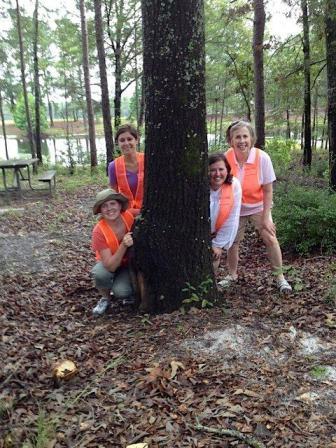
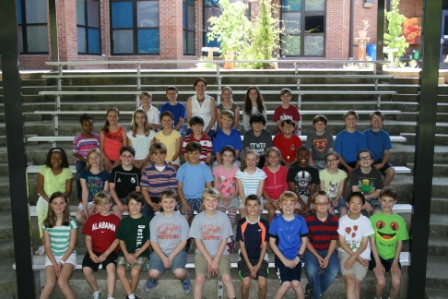 Ingleright teaches grades 3 through 5 in pull-out classes, but she stresses that PLT meets the needs of “all learning styles and students of all ages.”
Ingleright teaches grades 3 through 5 in pull-out classes, but she stresses that PLT meets the needs of “all learning styles and students of all ages.”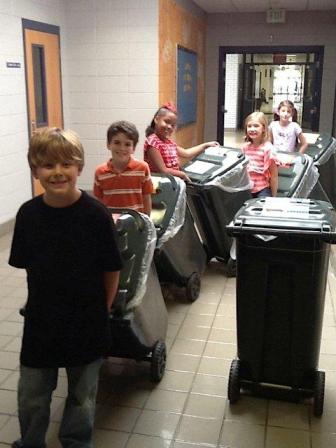 But perhaps the main lesson it taught him: “Kids can always make a difference in society.”
But perhaps the main lesson it taught him: “Kids can always make a difference in society.”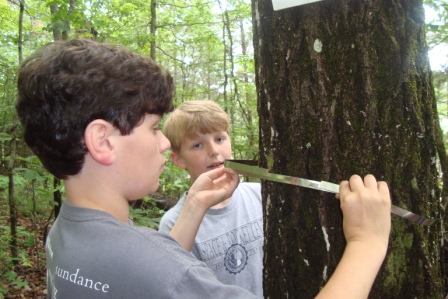 School Site Investigation
School Site Investigation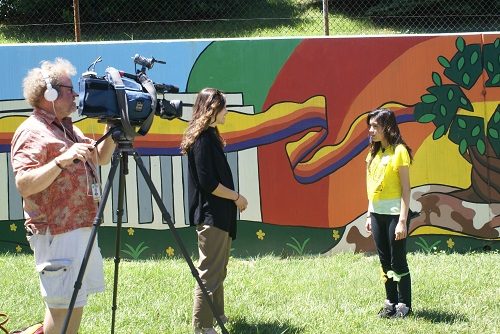
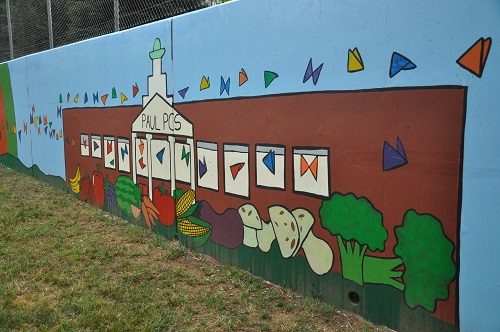 An immense wall used to be a huge, rusty cement eye sore, but there was no shortage of ideas from the kids about how to transform this corner of their school. They researched murals in D.C. and their impact on neighborhoods. They combined photos taken around the city with interviews of students and community members to develop a proposal for a mural with an eco-theme “D.C. is Going Green” that won the approval of school administration, community board members, and funders.
An immense wall used to be a huge, rusty cement eye sore, but there was no shortage of ideas from the kids about how to transform this corner of their school. They researched murals in D.C. and their impact on neighborhoods. They combined photos taken around the city with interviews of students and community members to develop a proposal for a mural with an eco-theme “D.C. is Going Green” that won the approval of school administration, community board members, and funders.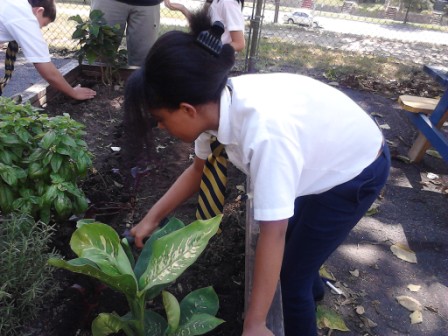 Most of the school’s Green Team projects have focused on getting students outdoors, working on the gardens they have created. The garden project started when I returned from an environmental education Peace Corps experience in Nicaragua and realized that my students in the U.S., all English Language Learners, could benefit from hands-on work with the environment.
Most of the school’s Green Team projects have focused on getting students outdoors, working on the gardens they have created. The garden project started when I returned from an environmental education Peace Corps experience in Nicaragua and realized that my students in the U.S., all English Language Learners, could benefit from hands-on work with the environment.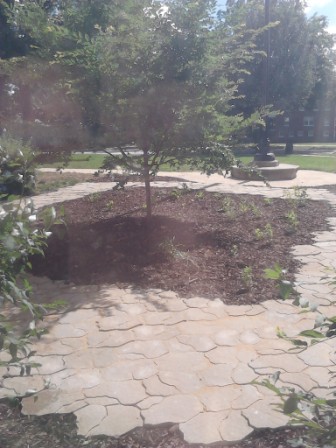 For Earth Day 2013, students created a new pollinator garden, bordered by an intricate stone walkway designed by a student. They worked for eight hours on the day before Earth Day to lay 4,000 pounds of stone; plant coneflowers, goldenrod, sunflowers, geraniums, and pepper bushes; and put up brightly-painted nest boxes for non-stinging bees to pollinate the flowers. We had been studying pollination in class since January, so this was a perfect project. It also taught teamwork and cooperation. The student who had the idea for the walkway had the design in her head. She trained other kids to lay the path because she couldn’t do it all herself. She also trained volunteers to help get it done.
For Earth Day 2013, students created a new pollinator garden, bordered by an intricate stone walkway designed by a student. They worked for eight hours on the day before Earth Day to lay 4,000 pounds of stone; plant coneflowers, goldenrod, sunflowers, geraniums, and pepper bushes; and put up brightly-painted nest boxes for non-stinging bees to pollinate the flowers. We had been studying pollination in class since January, so this was a perfect project. It also taught teamwork and cooperation. The student who had the idea for the walkway had the design in her head. She trained other kids to lay the path because she couldn’t do it all herself. She also trained volunteers to help get it done.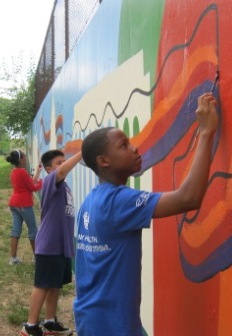 Tips for Teachers
Tips for Teachers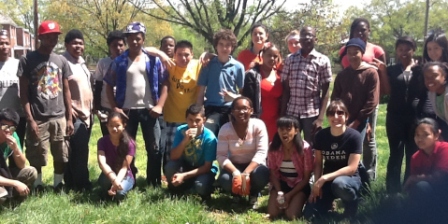 “We really care about each other and the environment, we’re like family trying to change everything,” 13-year-old Eleni Hailu told the Channel 7 news crew. “I’m so proud of us, I can’t wait to see what we do in the future,” added eighth-grader Nanci Reyes.
“We really care about each other and the environment, we’re like family trying to change everything,” 13-year-old Eleni Hailu told the Channel 7 news crew. “I’m so proud of us, I can’t wait to see what we do in the future,” added eighth-grader Nanci Reyes.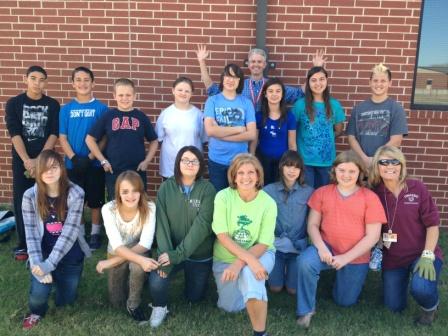 We’re proud to work for a school district in suburban Owasso, Oklahoma, that places a high value on environmental education. Even so, the PLT GreenSchools program at the Owasso 7th Grade Center is considered an extracurricular activity, rather than part of our school’s curriculum. Therefore, we have to tailor our GreenSchools Investigations so that they fit into occasional 30-minute Green Team meetings held before and after the regular school day. Keeping our work focused is extra challenging because the Green Team includes anywhere from 60 to 120 students at any given time, and different students participate in the morning and afterschool sessions.
We’re proud to work for a school district in suburban Owasso, Oklahoma, that places a high value on environmental education. Even so, the PLT GreenSchools program at the Owasso 7th Grade Center is considered an extracurricular activity, rather than part of our school’s curriculum. Therefore, we have to tailor our GreenSchools Investigations so that they fit into occasional 30-minute Green Team meetings held before and after the regular school day. Keeping our work focused is extra challenging because the Green Team includes anywhere from 60 to 120 students at any given time, and different students participate in the morning and afterschool sessions.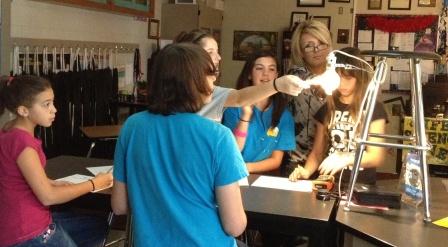 Energy Investigation
Energy Investigation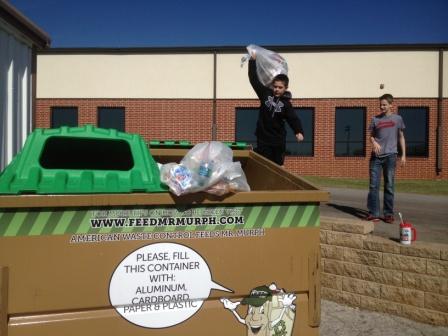 When new telephone directories started arriving on doorsteps in our community, it got our students thinking that almost no one uses phone books to look up numbers any more. They held a contest, with assistance from several local businesses, to see which classroom could collect the most phone books for recycling. Thanks to their efforts, we have been able to recycle 1,800 unwanted books—books that otherwise might have ended up in the landfill.
When new telephone directories started arriving on doorsteps in our community, it got our students thinking that almost no one uses phone books to look up numbers any more. They held a contest, with assistance from several local businesses, to see which classroom could collect the most phone books for recycling. Thanks to their efforts, we have been able to recycle 1,800 unwanted books—books that otherwise might have ended up in the landfill.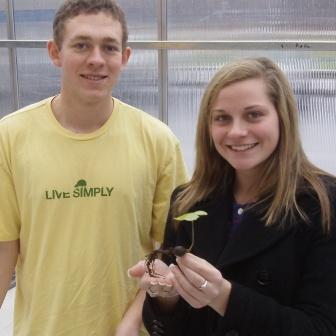 In the coming months, students will survey and remove invasive species surrounding a community nature trail, and re-vegetate the area with native plant species. They will design and create a trail guide to educate the public about the aesthetic value, rich diversity, and environmental importance of these native plants, and they’ll help their community understand the threats of invasive plants, and the importance of using native species in landscaping.
In the coming months, students will survey and remove invasive species surrounding a community nature trail, and re-vegetate the area with native plant species. They will design and create a trail guide to educate the public about the aesthetic value, rich diversity, and environmental importance of these native plants, and they’ll help their community understand the threats of invasive plants, and the importance of using native species in landscaping.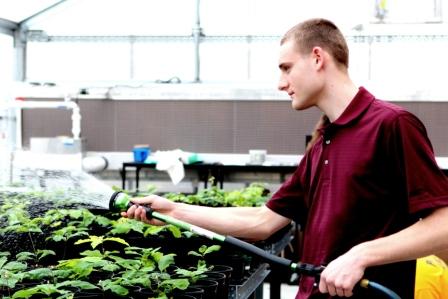 Our project is exceeding our expectations! We have had various experts in the field come to the greenhouse and share their expertise in raising native plant species. These experts have been impressed not only with our current projects, but also with our students’ involvement and eagerness to participate. Students are currently monitoring over 700 oak seedlings and 250 perennials.
Our project is exceeding our expectations! We have had various experts in the field come to the greenhouse and share their expertise in raising native plant species. These experts have been impressed not only with our current projects, but also with our students’ involvement and eagerness to participate. Students are currently monitoring over 700 oak seedlings and 250 perennials.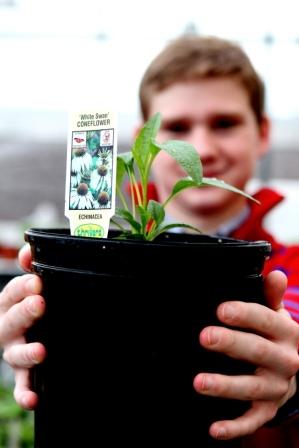
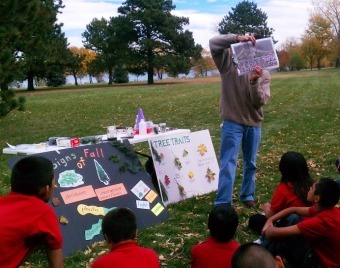 Multiplication usually results in ending up with more than you had at the start. That’s what happened with Environmental Learning Multiplied, or ELM, a program tat Sloan’s Lake Park in Denver.
Multiplication usually results in ending up with more than you had at the start. That’s what happened with Environmental Learning Multiplied, or ELM, a program tat Sloan’s Lake Park in Denver.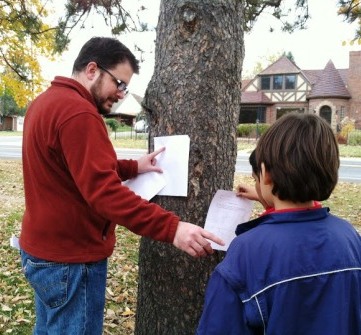
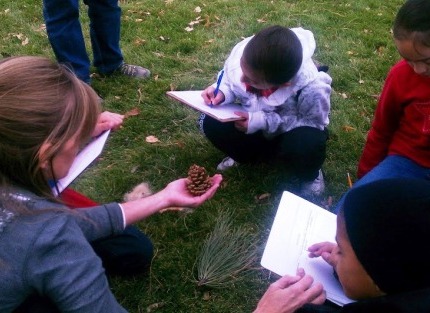 Finding time to teach a science lesson in a field experience can be challenging, given the amount of time devoted to literacy and math in the elementary curriculum. But PLT activities are a great way to incorporate teaching science with math and language arts. Thus, ELM provided a way for MSU students to fulfill a class assignment, and the opportunity to partner with a local elementary school and engage students in learning outside.
Finding time to teach a science lesson in a field experience can be challenging, given the amount of time devoted to literacy and math in the elementary curriculum. But PLT activities are a great way to incorporate teaching science with math and language arts. Thus, ELM provided a way for MSU students to fulfill a class assignment, and the opportunity to partner with a local elementary school and engage students in learning outside.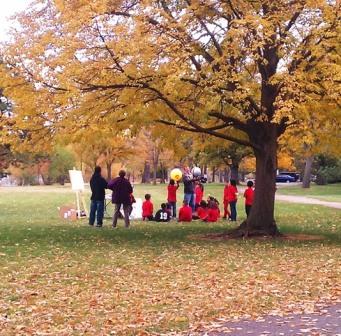 We were fortunate that the autumn weather was warm and the golden leaves remained on the trees. Students rotated from station to station with excitement and purpose.
We were fortunate that the autumn weather was warm and the golden leaves remained on the trees. Students rotated from station to station with excitement and purpose.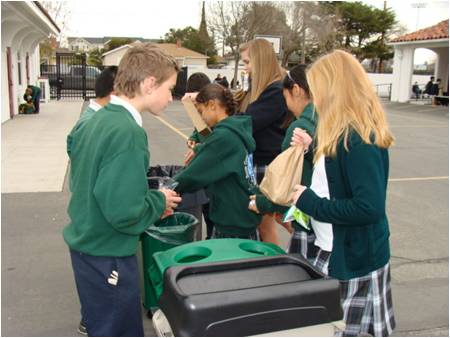 We have been amazed with the success of our school project to reduce waste. Students are working together to teach each other, their teachers, their parents, and community members about the importance of waste reduction, recycling and composting. The project has empowered students through leadership activities and given them a voice on campus.
We have been amazed with the success of our school project to reduce waste. Students are working together to teach each other, their teachers, their parents, and community members about the importance of waste reduction, recycling and composting. The project has empowered students through leadership activities and given them a voice on campus.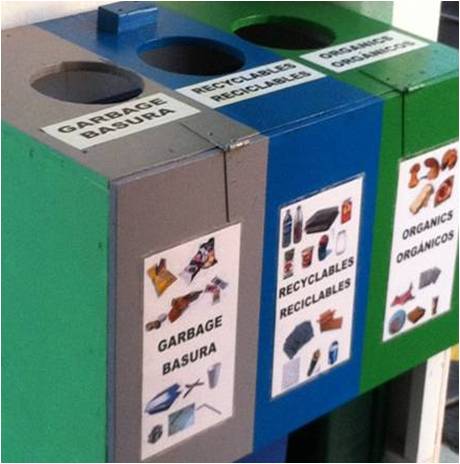 The Earth Team then set up waste collection bins in classrooms and around campus for proper sorting of waste. This project had many details that the students coordinated, including:
The Earth Team then set up waste collection bins in classrooms and around campus for proper sorting of waste. This project had many details that the students coordinated, including: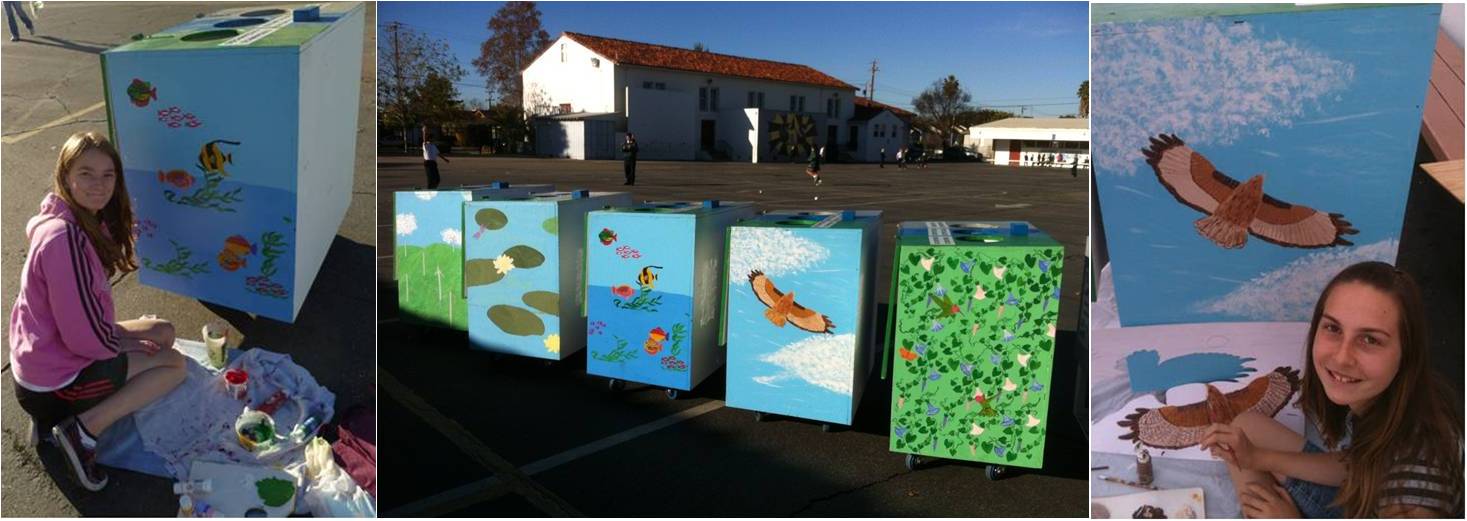
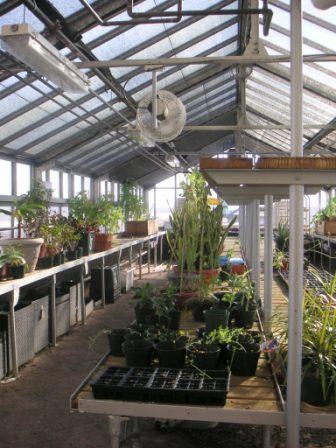 When McKinley Tech, built in 1912, underwent a complete renovation between 2002 and 2004, a large greenhouse was added to the updated school. There was just one problem: the greenhouse was unusable during much of the year because of Washington’s notoriously hot weather, which can begin in late spring and last into early autumn. The hot sun, focused through the greenhouse’s glass, spelled certain death for the plants inside, so the greenhouse remained unused for many years.
When McKinley Tech, built in 1912, underwent a complete renovation between 2002 and 2004, a large greenhouse was added to the updated school. There was just one problem: the greenhouse was unusable during much of the year because of Washington’s notoriously hot weather, which can begin in late spring and last into early autumn. The hot sun, focused through the greenhouse’s glass, spelled certain death for the plants inside, so the greenhouse remained unused for many years.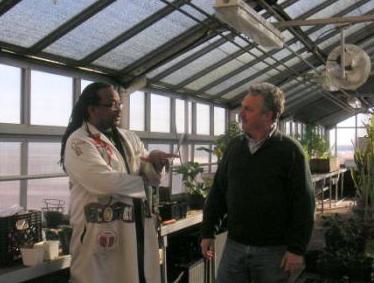 With the help of chef and Certified Master Gardener Mark Haskell, McKinley Tech students grew 12,000 vegetable seedlings to supply gardens at three other PLT GreenSchools in Washington. Each school has outdoor gardens that not only supply healthy, pesticide-free produce for students and their families, but also provide abundant learning opportunities.
With the help of chef and Certified Master Gardener Mark Haskell, McKinley Tech students grew 12,000 vegetable seedlings to supply gardens at three other PLT GreenSchools in Washington. Each school has outdoor gardens that not only supply healthy, pesticide-free produce for students and their families, but also provide abundant learning opportunities.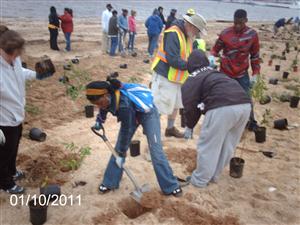 Students at Baltimore’s Ben Franklin High School are using their involvement with PLT GreenSchools and their proximity to Baltimore Harbor to tackle one environmental challenge after another, determined to make a difference in greening their school and community.
Students at Baltimore’s Ben Franklin High School are using their involvement with PLT GreenSchools and their proximity to Baltimore Harbor to tackle one environmental challenge after another, determined to make a difference in greening their school and community.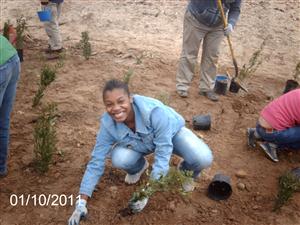 Using the PLT GreenSchools Environmental Quality Investigation, “the kids have studied pollution, met with and made recommendations to the school board, and developed a major presentation, which they gave several times to various community groups, on the need for clean, green spaces to serve our community,” said Joy. Ben Franklin’s Green Team also presented with the national PLT office at a regional National Science Teachers Association conference.
Using the PLT GreenSchools Environmental Quality Investigation, “the kids have studied pollution, met with and made recommendations to the school board, and developed a major presentation, which they gave several times to various community groups, on the need for clean, green spaces to serve our community,” said Joy. Ben Franklin’s Green Team also presented with the national PLT office at a regional National Science Teachers Association conference.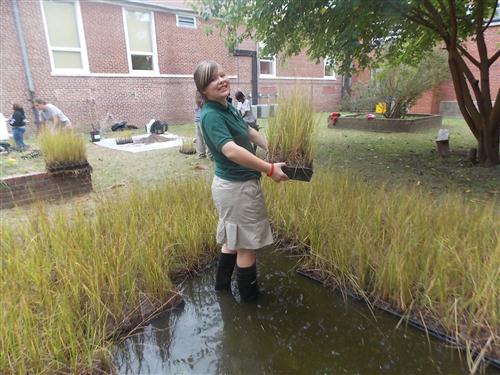 PLT GreenSchools encourages schools to develop community partnerships. As part of a partnership with the Baltimore Aquarium, Ben Franklin students raise bay grass in specially constructed wetland containers on the school’s grounds. When the plants mature, students transplant them to floating wetlands in Masonville Cove, where the grasses help filter the water and support marine wildlife.
PLT GreenSchools encourages schools to develop community partnerships. As part of a partnership with the Baltimore Aquarium, Ben Franklin students raise bay grass in specially constructed wetland containers on the school’s grounds. When the plants mature, students transplant them to floating wetlands in Masonville Cove, where the grasses help filter the water and support marine wildlife.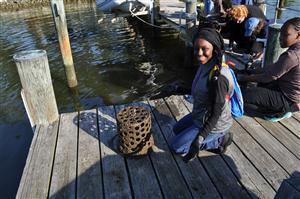 Oysters are another species critical to the health of the Chesapeake Bay’s economy, water, and wildlife. Over the years, the bay’s oyster populations have been reduced to just 2 percent of historic levels because of pollution, overfishing, and disease. Working with the South River Federation, Ben Franklin’s Green Team has undertaken an “oyster gardening” project, “planting” oysters in underwater cages suspended from a dock. When they reach maturity, the oysters are moved to a “sanctuary reef” farther out in the Bay, where they can help filter and clean the water while providing habitat for other marine wildlife.
Oysters are another species critical to the health of the Chesapeake Bay’s economy, water, and wildlife. Over the years, the bay’s oyster populations have been reduced to just 2 percent of historic levels because of pollution, overfishing, and disease. Working with the South River Federation, Ben Franklin’s Green Team has undertaken an “oyster gardening” project, “planting” oysters in underwater cages suspended from a dock. When they reach maturity, the oysters are moved to a “sanctuary reef” farther out in the Bay, where they can help filter and clean the water while providing habitat for other marine wildlife.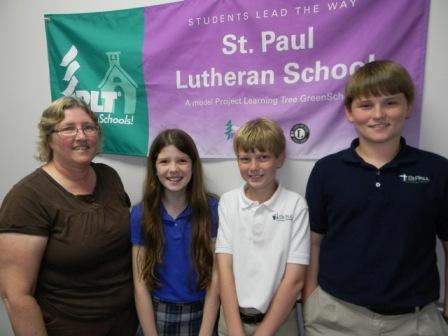 As a Florida PLT school, each class at St. Paul Lutheran, from preschool through grade 8, is involved in at least five PLT activities a year, many of which are conducted in outdoor classrooms.
As a Florida PLT school, each class at St. Paul Lutheran, from preschool through grade 8, is involved in at least five PLT activities a year, many of which are conducted in outdoor classrooms.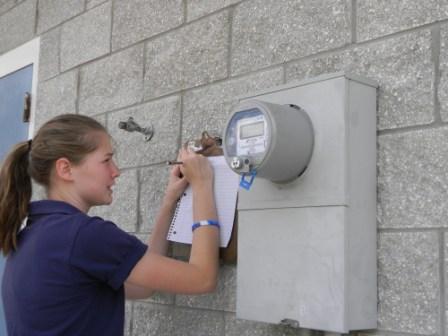 Classroom air-conditioning units now have “energy miser” equipment, and new energy-efficient computers were ordered for the computer lab. Students campaigned to get the school to share the cost with a PLT GreenWorks grant to switch florescent light bulbs in one building to STAR energy-saving light bulbs. They are now raising money to do the same for other buildings.
Classroom air-conditioning units now have “energy miser” equipment, and new energy-efficient computers were ordered for the computer lab. Students campaigned to get the school to share the cost with a PLT GreenWorks grant to switch florescent light bulbs in one building to STAR energy-saving light bulbs. They are now raising money to do the same for other buildings.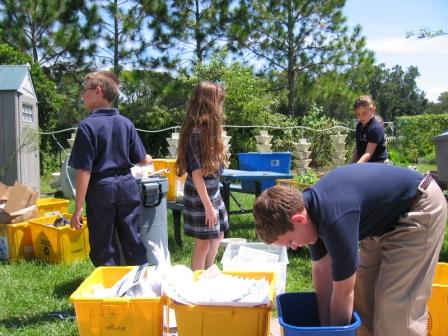 Through recycling, the school decreased its trash output in a school year by one-half of a dumpster, resulting in a savings of $225. The school has compost bins and worm bins, along with a yard waste compost area. The school’s learning standards relate to waste reduction and recycling, and the entire school cooperates with weekly recycling efforts.
Through recycling, the school decreased its trash output in a school year by one-half of a dumpster, resulting in a savings of $225. The school has compost bins and worm bins, along with a yard waste compost area. The school’s learning standards relate to waste reduction and recycling, and the entire school cooperates with weekly recycling efforts.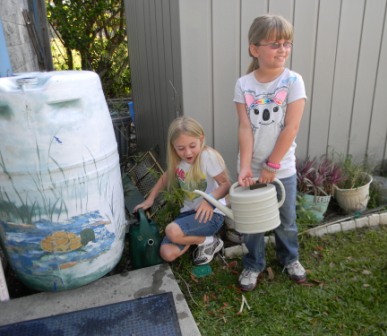 Students check faucets, toilets, and water fountains for leaks to make sure water is not being wasted. Rain barrels are used to irrigate gardens, flowerbeds, and other areas on campus. Fifty-five gallons of water are collected daily from condensation from the metal roofs.
Students check faucets, toilets, and water fountains for leaks to make sure water is not being wasted. Rain barrels are used to irrigate gardens, flowerbeds, and other areas on campus. Fifty-five gallons of water are collected daily from condensation from the metal roofs. 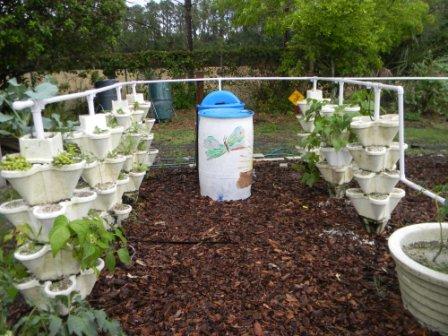 The gardens use hydroponics and drip irrigation, and SoxxTM to reduce water run-off and help stop erosion.
The gardens use hydroponics and drip irrigation, and SoxxTM to reduce water run-off and help stop erosion.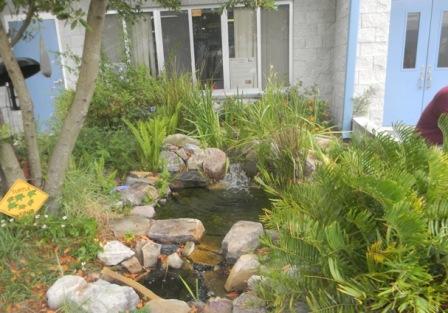 Students helped design and build a turtle and rain garden as an action project associated with their GreenSchool findings. A nearby gutter and downspout provide the water source for the pond. For the wetland garden, students in grades 4 and 5 surveyed their peers, parents, faculty, and community members for suggestions. Students had leadership opportunities from the beginning, participating in almost all areas of the project—from planning pond design, to planting seeds, to making presentations to other classes in the school. Students also learned to work with community partners, such as the local Extension Office and the Lakeland Garden Club. These partners helped students and faculty learn about selecting and planting native plant species. Students presented this project as part of a webinar for the national PLT office.
Students helped design and build a turtle and rain garden as an action project associated with their GreenSchool findings. A nearby gutter and downspout provide the water source for the pond. For the wetland garden, students in grades 4 and 5 surveyed their peers, parents, faculty, and community members for suggestions. Students had leadership opportunities from the beginning, participating in almost all areas of the project—from planning pond design, to planting seeds, to making presentations to other classes in the school. Students also learned to work with community partners, such as the local Extension Office and the Lakeland Garden Club. These partners helped students and faculty learn about selecting and planting native plant species. Students presented this project as part of a webinar for the national PLT office.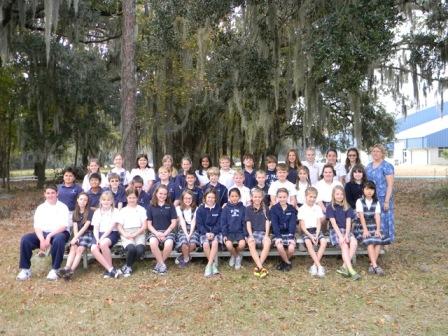 The school has adopted an Integrated Pest Management (IPM) plan. (IPM is a sustainable approach to managing pests by combining biological, cultural, physical, and chemical tools in a way that minimizes economic, health, and environmental risks.) Proper warning signs are posted when pesticides are used.
The school has adopted an Integrated Pest Management (IPM) plan. (IPM is a sustainable approach to managing pests by combining biological, cultural, physical, and chemical tools in a way that minimizes economic, health, and environmental risks.) Proper warning signs are posted when pesticides are used.